14900K at 7.7 GHz: How I Set 50 Overclocking Info with Intel’s Raptor Lake Refresh CPUs and A great deal of Liquid Nitrogen
Welcome once more to the gratifying manufacturing facility, aka, my basement laptop computer lab — the realm the place the distinctive turns into the same old. Instantly’s journey will uncover the acute side of overclocking, focused totally on the PC’s thoughts, the processor. I simply currently nailed an entire of fifty world data with Intel’s 14th Gen “Raptor Lake Refresh” CPUs. Quite a lot of these nonetheless stand as of this writing (people are always posting new ones to HWBot), along with 15 world data with the Core i7-14700K and eight data with the Core i5-14600K, along with 4 data with the Core i9-14900K, spanning benchmarks from Cinebench to wPrime and H265.
My excessive speeds have been 7,730.11 MHz on all cores on the 14900K, 7,859.05 MHz on the 14600K and 7,600 MHz on the 14700K. All of these achieved in Cinebench R23 whereas using Liquid Nitrogen cooling.
| CPU | Most Clock (All-Core) | Stock Max Velocity | Cores / Threads |
|---|---|---|---|
| Core i9-14900K | 7,730.11 MHz | 6,000 MHz | 24 (8P + 16E) / 32 |
| Core i7-14700K | 7,600 MHz | 5,600 MHz | 20 (8P + 12E) / 28 |
| Core i5-14600K | 7,859.05 MHz | 5,300 MHz | 14 (6P + 8E) / 20 |
The hero of the day? Intel’s new little one is the Raptor Lake Refresh processors, led by the Core i9-14900K. The current newest flagship for the mainstream (will we get KS, maybe?) is clocked extreme out of the sphere, so what have they left for us to hunt out on our private? Is that this processor, as the children say, a “straightforward thoughts” or a “wrinkle thoughts?” Let’s uncover out.
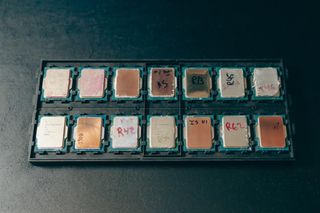
“OC is lifeless!” some cry. Correctly, certain and no. Intel is pushing the turbo arduous on these processors, which works good. Pushing upwards of 6 GHz was a dream not even a 12 months previously, and it is seemingly the model new commonplace. “Nevertheless that’s not on all cores.” Correctly, even I “cheat” the bounds of the system by working an asynchronous per-core clock ratio on LN2. Why limit your self to your weakest core?
I imagine OC is altering. Relying in your motherboard and the best way they prepare vitality and temperature limits, you might even see a steady effectivity uplift from strapping on larger cooling and altering nothing the least bit! You don’t even should enter the BIOS, nevertheless there is a perform in most BIOS now known as Intel Current Limits. Many producers have this disabled, even at stock settings. So, must you aren’t following the Intel current limits, is your motherboard “overclocking” for you? If OC is lifeless, why is that this even an alternative? Probably you are an overclocker, and you don’t even notice it!
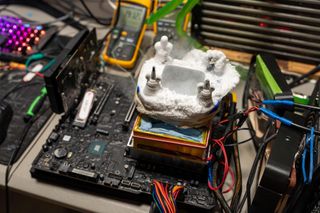
Let’s overclock! For full transparency, I’ve many shut relations inside the PC enterprise, and a number of other different sources supplied these CPUs. They must be considered bigger top quality than a conventional random draw. That being said, six out of six ran Cinebench R23 at 5.9 GHz on water cooling with all cores synced, and 5 out of six ran Cinebench R23 at 6.0 GHz on water cooling with all cores synced. Certain, 6 GHz!
The 14900K is seemingly solely a better 13900K, correct? On the similar MSRP, is {{that a}} win? For those who’re supplied a better automotive for the same value a 12 months later, is {{that a}} entire lot? Is that this very true inside the 2020s interval /covid/greed/inflation?
So, with completely manually managed settings with no turbo and a tough and quick clock cost, the 14900K is the similar as a result of the 13900K as far as effectivity is frightened. Good. On this case, which implies to interrupt data, we’re going to need pure clock velocity enhancements. Probably we’re going to see a 7.19424% enhance in clocks (13900K % purchase to 14900K)?
For my record-setting makes an try, I reap the benefits of my trusty ASRock Z690 Aqua OC motherboard. It’s a two-DIMM board for larger memory overclocking, which helps the benchmarks we usually run score bigger than with a four-DIMM board. It’s about considerably over a 12 months outdated and nonetheless runs sturdy. Why not a Z790 motherboard if I’ve entry to irrespective of I would really like? Correctly, to me, Z790 is simply a very completely different determine for the same issue, similar to the 13900K is to the 14900K.
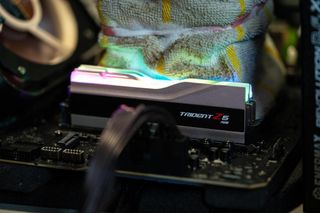
The ENERMAX Revolution D.F. X 1050W ARGB powers the system. It’s 80-plus Gold, it’s tiny, and the cables are large versatile so that I can maintain them out of the best way through which of all my followers and LN2 containers merely. It handles the system on LN2 with no sweat.
For memory, I always choose G.SKILL. These are their DDR5 Trident Z5 7800 MHz RGB sticks in Silver. When pushing the bounds, you need any edge you’ll get. Just a little bit lower latency or further bandwidth can take you from silver to gold. That’s the reason I reap the benefits of G.SKILL and their bigger frequency kits. Prefer it or hate it, the RGB seems good and offers 100 elements to my Cinebench scores (merely kidding).
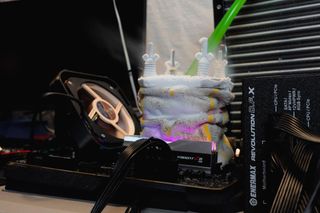
With my star-studded branded powerhouse of a system slapped collectively, we are going to lastly work up an overclock. Cinebench R20, although rising older now, seems to be the enterprise commonplace for OC measurement, so I usually start there. It’s moreover a fairly prolonged, continuously high-load check out. It truly exams your cooling instruments, identical to the CPU LN2 container and thermal paste. I’m using Der8auer’s Thermal Grizzly Kryonaut thermal paste in the mean time and a Reaktor CPU container.
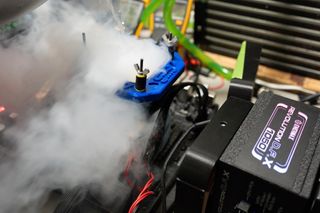
These CPUs do not love very extreme voltage: It generates an extreme quantity of heat and creates a downward spiral of extreme wattage, extreme temps, and regular inefficiency. We want to run as cool as attainable with as little voltage as attainable, with clocks as extreme as attainable for sturdy scoring and effectivity. For perspective, the max voltage I consider using with common cooling (AIO, and so forth.) is spherical 1.4-1.45V. This might get you into the 100C house, and presumably thermal throttling on the very extreme end.
On LN2, I’m solely using +200mV better than that. Many assume these are throw-away CPUs and garbage after getting used on LN2, nevertheless that is faraway from the truth – the CPU will remaining quite a few courses in these circumstances. It is really unusual for me to kill or wound {{hardware}}, and after I do, I take it as a non-public failure. I’ve a small graveyard in my yard the place I do a quick service to pay my respects to fallen {{hardware}} heroes.

Listed beneath are some further little tidbits for you: When the CPU pot is full, the temperature probe reads -192C. After I start the benchmark, it could attain as extreme as -189C, combating in the direction of the chilly face of the CPU pot full of liquid nitrogen. The exact die temperature shall be rather a lot bigger than that.
Frozen thermal paste won’t be the perfect conductor, and some sturdy forces work in the direction of each other in that weak layer. Typically, the chilly will overwhelm the thermal paste, and it will each crack or separate itself from one side of what it is imagined to be cooling. In that case, it could grow to be further of an insulator than a conductor, and nothing will run.
The CPU will attain a optimistic temperature although the metallic container millimeters away from it is an insane -190C. When this happens, it is necessary to tear each half apart and start over. It’s a big quantity, and an entire timesuck. Thankfully, this solely occurred as quickly as all through my benching session, and it was my fault.

On the end of each week of collaborating in spherical, I broke the 8-core Cinebench doc at a crazy 7.73 GHz on all cores! In full, I managed over 50 data between the i5, i7, and i9 processors which have been refreshed. They are a breeze to overclock and really gratifying to work with. Complete, these CPUs most likely OC larger than their predecessors and worth the similar. It was a fairly refreshing refresh, I might say.
Disclosure: ASRock, Enermax, Intel, G.Skill, and Thermal Grizzly contribute to my overclocking success.






